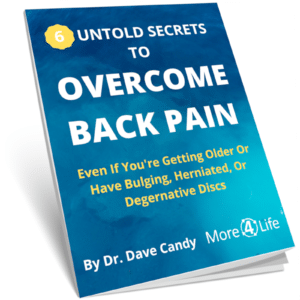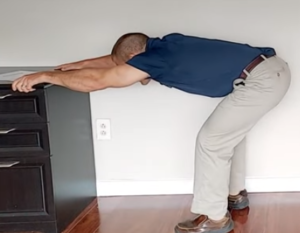If you're considering having decompression therapy for your spine, make sure to watch this video and read the article below to save yourself a bunch of time and money. You'll learn:

What is Spine Decompression Therapy?
Spine decompression therapy is essentially traction. It's usually done at a chiropractor or sometimes a physical therapist's office.
They put you on a table, where they strap you in around your chest and waist, and then stretch you apart in what looks like a medieval torture device.
In fact, a lot of times when I worked in clinics that had spine decompression therapy tables, patients would joke, "Hey, that looks like you're going to strap me into the rack."
How Is Spine Decompression Therapy Supposed To Work?
When you stretch or "decompress" the spine, it's supposed to relieve pressure off of the discs and help centralize a herniation.
Surgical vs. Non-Surgical Spinal Decompression Therapy
How is non-surgical spinal decompression therapy different from surgical spinal decompression?
Spine Decompression Surgery
Surgical decompression of the spine involves taking anatomical pressure off of the spinal cord.
It's usually used in people who have radiating pain, numbness, or weakness down in their legs, or who have loss of bowel and bladder control.
Surgical spinal decompression can include:
- Laminectomy - cutting a piece of the bone called the lamina out of the vertebrae to create more space for the spinal cord so that it isn't compressed.
- Discectomy - trimming way a piece of a herniated disc in order to decompress the spine.
Surgical decompression usually involves relieving circumferential compression of the spine.
Non-surgical Spinal Decompression Therapy
Conversely, non-surgical spinal decompression therapy is a longitudinal stretching or vertical decompression of the spine.
It's very different in concept to surgical decompression.
However, it's been very well marketed under the term "spinal decompression therapy" because it's used as an alternative to surgery.
And naturally, most people want to avoid because there are a lot of risks with spine decompression surgery including:
- death
- spinal cord or nerve injury
- infection
...or just spending a lot of money, and it not working.
So "non-surgical spinal decompression therapy" been very well marketed.
But does it really work?
Does Spinal Decompression Therapy Really Work?
An article in Chiropractic and Osteopathic published in 2007 sought to answer that exact question:
Non-surgical spinal decompression therapy: does the scientific literature support efficacy claims made in the advertising media?
This article was published by Dwain Daniel, a researcher at Parker Chiropractic College.
The conclusion was "Only limited evidence is available to warrant the routine use of non-surgical spinal decompression, particularly when many other well investigated, less expensive alternatives are available."
Furthermore, clinical practice guidelines and systematic reviews don't support the use of traction or spine decompression therapy for lower back pain.
Even a 2020 NBC news report reveals that "Patients pay thousands for back pain treatment — with little scientific evidence that it works."
However, "non-surgical spinal decompression therapy" is easy to sell to people who are suffering in pain and desperate to get relief and avoid surgery at all costs.
Often it can give a little bit of short-term relief, which makes people think that it's working.
So if you are suffering from pain, stretching your spine, taking some pressure off the discs can often feel really good.
...but it's probably not going to solve your problem in the long term.
The Gravity Effect
All spinal decompression therapy really does, is stretch or decompress your spine vertically.
However, gravity compresses your spine all day long.
A typical spinal decompression therapy protocol might involve 30-minute treatments daily for 2 weeks (10 sessions), then 3 times per week for 2 weeks (6 sessions), and then 2 times per week for 2 weeks (2 sessions).
Sometimes more.
So you're looking in the range of 20-50 sessions of therapy.
But even if you go daily for 30-minutes per day, anytime you're in an upright position, gravity is re-compressing your spine.
Once you finish your spine decompression therapy and get back to your normal activities, gravity is just going to start re-compressing your spine again, negating any of the effects that you've invested so much time and money to get.
In fact, there's something called a rebound phenomenon that can happen immediately after spinal decompression therapy where you stand back up and reload the discs and the nerves, and you get a sudden increase in symptoms.
In summary, spinal decompression therapy is probably not worth the cost in the long-term
However, decompressing your spine CAN feel good in the short term. And fortunately there are some free and low-cost alternatives to formal spinal decompression therapy.
Spinal Decompression At Home Exercises
So if you're looking to avoid spending a lot of money on a treatment that's not going to give you much long-term relief, then there are a couple of at-home spine decompression therapy options.
Spinal decompression feels good in the short term, but you have to do it often if you want to maintain the effects.
So having some ways that you can do it on your own at home are much more cost-effective in the long term because you don't have to go somewhere and shell out money every time you want to decompress your spine.
One really great way to do that is just to lean over a desk or hold onto a doorknob or other stationary object.
You're taking gravity off because gravity presses down on you vertically, and when you put your spine horizontal, gravity is no longer compressing your spine.
Then you hold on to the desk and just lean back. This gives you further decompression of your spine.
You could also grab the top of the door frame and just bend your knees a little bit and let it stretch you out as an alternative
Or you can hang from a pullup bar if your arms and your grip are strong enough to support your entire bodyweight.
All of those are great forms of spinal decompression that you can do on demand with very little equipment, anytime you want.
So in my opinion, those are MUCH more effective and certainly more cost-effective treatments or forms of spinal decompression therapy than going somewhere and getting stretched on the traction table.
Spine Decompression Braces
If you want something that you can use for spinal decompression therapy as you're going about your day, there are some spinal decompression braces.
One example is the DDS 300 Back Decompression Brace.
You just put it around your waist like you would with a normal back brace.
However, it also comes with a pump that inflates air columns within the brace. These air columns expand vertically to decompress your spine.
This allowsyou to walk around and move around with less discomfort and with less compression on your spine.
Now, does it fix the problem?
No, absolutely not.
But it does allow you to stand longer go about your day, wash dishes, go to the store, go do things with your kids, your grandkids, or friends, and not suffer quite so much.
So while it doesn't actually fix the problem, it can improve your quality of life.
If you think the DDS 300 Back Decompression Brace is something you're interested in, you can buy one here, and use my discount code DRCANDY10 to save 10%.
Conclusion
In review, "non-surgical spinal decompression therapy" that you receive a a chiropractor or physical therapist's office isn't probably as effective as they're marketed to be.
They're certainly not as cost effective as just doing spine decompression therapy exercises at home.
Furthermore, for just a relatively small amount of money, you can purchase a spine decompression brace that you can use whenever and wherever you want.
One Final Note On Spine Decompression Therapy
No matter what type of spine decompression therapy you do - either with a machine, with exercises, or with a brace - it's just a temporary fix.
In order to get long-term relief from back pain and sciatica, you have to address the underlying cause of the problem.
Otherwise, the decompression treatment might feel god for awhile, but the pain will eventually come back.
If you live in the St. Louis area and would like to find a long-term solution to your back pain or sciatica, we'd be happy to help you here at More 4 Life.
Just tap the button below to request an appointment with one of our specialist physical therapists.
Like this post? Check out some of our other post about exercises for lower back pain
Lean Forward When Walking? 3 Exercises to Stop Walking Hunched Over
Things To Avoid With Degenerative Disc Disease and What To Do Instead
8 Stretches For Lower Back Pain and Hip Mobility
7 Exercises For Arthritis In Lower Back







